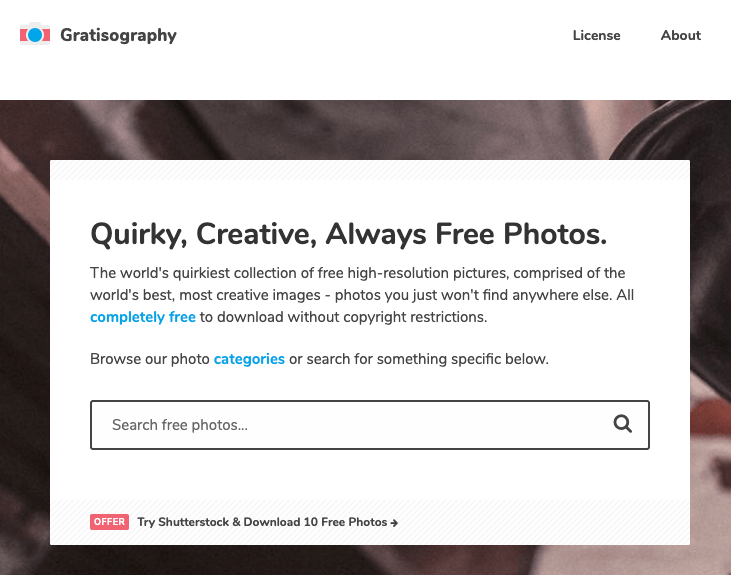Finding high-quality images for your projects without breaking the bank can be a challenge. Luckily, there are plenty of websites that offer free HD images you can download and use legally. These platforms are perfect for bloggers, designers, students, and anyone needing stunning visuals without the hefty price tag. Whether you’re working on a website, presentation, or social media post, having access to a diverse selection of free images can make your content stand out. In this post, we’ll explore some of the top free alternatives to Shutterstock that provide excellent HD images for your creative needs.
Popular Free Alternatives to Shutterstock

If you’re looking for free stock images that match or even surpass Shutterstock in quality, you’re in luck. Here are some of the most popular and reliable platforms where you can find beautiful, high-resolution images at no cost:
- Pexels: Known for its extensive library of free HD images and videos, Pexels offers a user-friendly experience. All images are licensed under Creative Commons Zero (CC0), meaning you can use them for personal and commercial projects without attribution.
- Unsplash: Famous for its stunning, high-resolution photos shared by talented photographers worldwide. Unsplash’s library covers a wide range of topics, from nature and travel to technology and business. The images are free to use for any purpose, with no attribution required.
- Pixabay: Offering not just photos but also vectors, illustrations, and videos, Pixabay is a versatile resource. All content is released under a simple license that allows free use, even commercially.
- Gratisography: If you’re after quirky and unique images that stand out, Gratisography is the place to go. The site features high-resolution images taken by photographer Ryan McGuire, all free for personal and commercial use.
- StockSnap.io: Regularly updated with hundreds of new images, StockSnap.io offers a wide range of HD photos. Its easy search function and CC0 licensing make it a favorite among content creators.
These sites not only provide high-quality images but also ensure that you can use them freely without worrying about licensing issues. Whether you’re after a breathtaking landscape, a professional business shot, or something more abstract, these platforms have you covered.
3. Features and Benefits of Each Platform
When exploring free image sources, it’s helpful to understand what each platform offers and how it can benefit your projects. Let’s take a closer look at some popular options and see what makes them stand out.
Unsplash is renowned for its vast library of high-quality, royalty-free images contributed by a passionate community of photographers. The platform boasts over a million images covering a wide range of topics—from nature and travel to technology and abstract designs. Its user-friendly interface makes browsing and downloading effortless, and images are available in HD without any restrictions. The main benefit? You get access to stunning, professional-grade photos for free, which can be used commercially or personally without attribution (though credit is appreciated).
Pexels offers a similarly impressive collection of free HD images and videos. What sets Pexels apart is its curated content, meaning images are carefully selected for quality and relevance. The platform also features a powerful search function that makes finding specific images quick and easy. Benefits include:
- High-resolution images suitable for print and digital use
- Easy download options with no registration required
- Regularly updated content to keep your options fresh
Pixabay is a comprehensive resource that goes beyond photos—it offers illustrations, vectors, and even videos. With over 1.9 million assets, Pixabay is a treasure trove for creators needing diverse media types. One standout feature is its intuitive categorization, helping you find images for specific themes effortlessly. Benefits include:
- Wide variety of media types, including vectors and illustrations
- Images are released under Creative Commons Zero (CC0), allowing unrestricted use
- Integrated editing tools for quick modifications
In summary, each platform brings unique strengths—whether it’s Unsplash’s beautiful photography, Pexels’ curated content, or Pixabay’s versatility. Choosing the right one depends on your specific needs, project type, and preferred style of images.
4. How to Choose the Best Free Image Source for Your Needs
With so many free image platforms out there, picking the right one can feel overwhelming. Here are some key factors to consider that will help you make an informed decision and find the perfect images for your project.
1. Purpose of Your Project
Ask yourself: Are you creating a professional presentation, a blog post, social media content, or a print flyer? Different projects require different image qualities and styles. For high-quality print materials, you’ll want platforms offering HD or higher resolution images like Unsplash or Pexels. For digital-only content, standard HD images might suffice.
2. Licensing and Usage Rights
Even free images come with licensing terms. Ensure the platform offers images under licenses that suit your needs. Platforms like Pixabay and Pexels typically provide images under CC0, meaning you can use them freely for commercial and personal purposes without attribution. Always double-check the license to avoid legal issues down the line.
3. Quality and Variety
Look for platforms that prioritize high resolution and provide a diverse range of images. Browse a few samples to gauge quality. If you need niche or specific images, check if the platform’s categories and search capabilities are robust enough to meet your demands.
4. Ease of Use and Accessibility
Select a platform with a simple, intuitive interface. The easier it is to search, preview, and download images, the more efficient your workflow will be. Also, consider whether the platform allows quick bulk downloads if needed.
5. Additional Features
Some platforms offer extra tools—like editing features, collections, or the ability to create custom searches. These can be helpful if you want to customize images or organize your favorites.
In essence, the best free image source aligns with your project goals, offers licensing clarity, provides high-quality and diverse images, and is easy to navigate. Take a moment to evaluate your needs against these factors, and you’ll be well on your way to finding the perfect images for free!
5. Tips for Using Free Stock Photos Effectively
Using free stock photos can be a fantastic way to elevate your projects without breaking the bank, but it’s important to do it wisely. Here are some tips to help you make the most of these images and ensure your content looks professional and authentic.
Choose Relevant and Authentic Images
First and foremost, pick photos that genuinely match your message or brand identity. Avoid generic or overly staged images that might seem out of place. Authentic photos that reflect real-life scenarios tend to resonate more with viewers and add credibility to your content.
Pay Attention to Licensing Terms
Even if an image is free, it might have specific usage restrictions. Always read the licensing details carefully. Some images require attribution, while others are completely free to use without credit. Respect these rules to stay compliant and avoid legal issues.
Optimize Image Quality and Size
High-resolution images are great, but they can also slow down your website if not optimized. Use tools like TinyPNG or ImageOptim to reduce file sizes without losing quality. This helps your pages load faster, improving user experience and SEO rankings.
Maintain Consistency in Style
Try to use images that have a similar style or color palette to create a cohesive look across your project. Consistency helps reinforce your branding and makes your content more visually appealing.
Enhance with Editing Tools
Feel free to customize free stock photos using editing tools like Canva or Adobe Spark. Adjust brightness, contrast, or add overlays to better match your branding. Just be cautious not to over-edit—authenticity matters!
Be Creative and Think Outside the Box
Don’t just stick to typical photos. Explore unique angles, compositions, or concept shots that can make your content stand out. Sometimes, a creative twist on a common image can make a big impact.
6. Conclusion and Final Recommendations
Using free HD images from alternatives to Shutterstock is a smart move for creators, bloggers, and small businesses aiming to produce high-quality content without extra costs. The key is to select images thoughtfully, respecting licensing rules, and customizing them to match your style and message.
Remember, the right image can tell a story, evoke emotion, and strengthen your brand’s identity. So, take the time to explore these platforms, experiment with different visuals, and always aim for authenticity. By following these tips, you’ll be well on your way to creating engaging, professional-looking content that resonates with your audience.
Happy designing, and don’t forget—great visuals are just a few clicks away, even on a tight budget!


